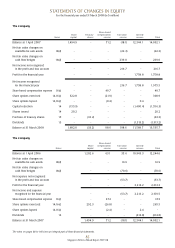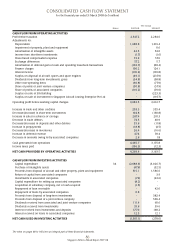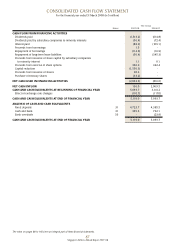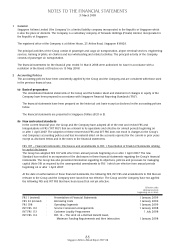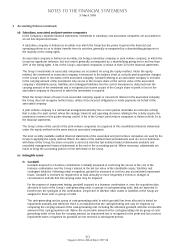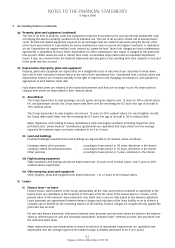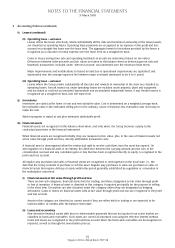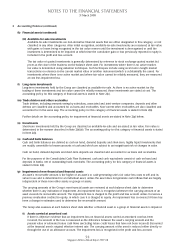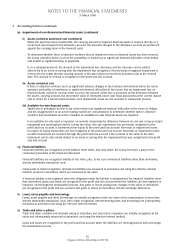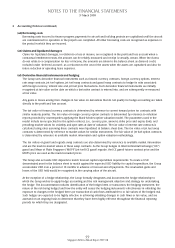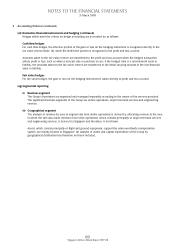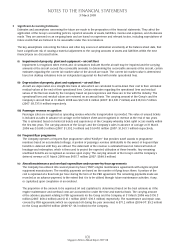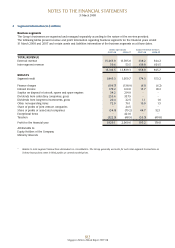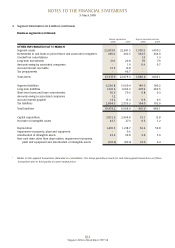Singapore Airlines 2008 Annual Report Download - page 97
Download and view the complete annual report
Please find page 97 of the 2008 Singapore Airlines annual report below. You can navigate through the pages in the report by either clicking on the pages listed below, or by using the keyword search tool below to find specific information within the annual report.Singapore Airlines Annual Report 2007-08
95
2 Accounting Policies (continued)
(p) Impairment of non-financial and financial assets (continued)
(i) Assets carried at amortised cost (continued)
When the asset becomes uncollectible, the carrying amount of impaired financial assets is reduced directly or if
an amount was charged to the allowance account, the amounts charged to the allowance account are written off
against the carrying value of the financial asset.
To determine whether there is objective evidence that an impairment loss on financial assets has been incurred,
the Group considers factors such as the probability of insolvency or significant financial difficulties of the debtor
and default or significant delay in payments.
If, in a subsequent period, the amount of the impairment loss decreases and the decrease can be related
objectively to an event occurring after the impairment was recognised, the previously recognised impairment is
reversed to the extent that the carrying amount of the asset does not exceed its amortised cost at the reversal
date. The amount of reversal is recognised in the profit and loss account.
(ii) Assets carried at cost
If there is objective evidence (such as significant adverse changes in the business environment where the issuer
operates, probability of insolvency or significant financial difficulties of the issuer) that an impairment loss on
financial assets carried at cost has been incurred, the amount of the loss is measured as the difference between
the asset’s carrying amount and the present value of estimated future cash flows discounted at the current market
rate of return for a similar financial asset. Such impairment losses are not reversed in subsequent periods.
(iii) Available-for-sale financial assets
Significant or prolonged decline in fair value below cost, significant financial difficulties of the issuer or obligor,
and the disappearance of an active trading market are considerations to determine whether there is objective
evidence that investment securities classified as available-for-sale financial assets are impaired.
If an available-for-sale asset is impaired, an amount comprising the difference between its cost (net of any principal
repayment and amortisation) and its current fair value, less any impairment loss previously recognised in the
profit and loss account, is transferred from equity to the profit and loss account. Reversals of impairment losses
in respect of equity instruments are not recognised in the profit and loss account. Reversals of impairment losses
on debt instruments are reversed through the profit and loss account if the increase in fair value of the debt
instrument can be objectively related to an event occurring after the impairment loss was recognised in the profit
and loss account.
(q) Financial liabilities
Financial liabilities are recognised on the balance sheet when, and only when, the Group becomes a party to the
contractual provisions of the financial instrument.
Financial liabilities are recognised initially at fair value, plus, in the case of financial liabilities other than derivatives,
directly attributable transaction costs.
Subsequent to initial recognition, all financial liabilities are measured at amortised cost using the effective interest
method, except for derivatives, which are measured at fair value.
A financial liability is derecognised when the obligation under the liability is extinguished. For financial liabilities other
than derivatives, gains and losses are recognised in the profit and loss account when the liabilities are derecognised or
impaired, and through the amortisation process. Any gains or losses arising from changes in fair value of derivatives
are recognised in the profit and loss account. Net gains or losses on derivatives include exchange differences.
(r) Loans, notes payable and borrowings
Loans, notes payable and other borrowings are initially recognised at the fair value of the consideration received less
directly attributable transaction costs. After initial recognition, interest-bearing loans and borrowings are subsequently
measured at amortised cost using the effective interest method.
(s) Trade and other creditors
Trade and other creditors and amounts owing to subsidiary and associated companies are initially recognised at fair
value and subsequently measured at amortised cost using the effective interest method.
Gains and losses are recognised in the profit and loss account when the liabilities are derecognised as well as through
the amortisation process.
NOTES TO THE FINANCIAL STATEMENTS
31 March 2008


